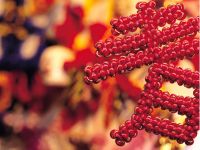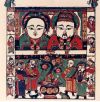Difference between revisions of "Chinese New Year Holiday"
imported>Conan |
imported>Conan |
||
| Line 50: | Line 50: | ||
|- | |- | ||
| − | |[[ | + | | [[Image:Nianhuaa.jpg|thumb|left|100px]] |
| − | '''[[Spring Festival#Nianhua|Nianhua]]''' (Spring Festival Picture) is a special type of painting in China. It is used during the [[Spring Festival]]. ('''[[Spring Festival#Nianhua|Read more ...]]''') | + | '''[[Spring Festival#Nianhua|Nianhua]]''' (Spring Festival Picture) is a special type of painting in China. It is used during the [[Spring Festival]]. ('''[[Spring Festival#Nianhua|Read more ...]]''') |
| + | |||
| + | |||
| + | |||
| + | |||
| + | [[File:springcouplets1.jpg|thumb|100px|left]] | ||
| + | On the Chinese New Year, families in China decorate their front doors with '''[[Spring couplets]]''' - the poetic couplets of calligraphy written with fragrant India ink, expressing the feeling of life's renewal and the return of spring. ('''[[Spring couplets|Read more ...]]''')<br> | ||
| + | |||
| | | | ||
|} | |} | ||
=== === | === === | ||
Revision as of 03:04, 8 February 2010
ContentsChinese New Year Holiday |
|
Chinese New Year, or Spring Festival is the largest and most important festival in China. It is the first day of the lunar calendar and usually occurs somewhere between January 30 and February 20, heralding the beginning of spring, thus it is known as Spring Festival. This traditional festival is also a festival of reunion; no matter how far away people are from their homes, they will try their best to get back to have the Reunion Dinner. (Read more ...) |
Related festivals |
Customs |
|
Little New Year (Chinese: Xiaonian), which falls about a week before the lunar New Year, is also known as the Festival of the Kitchen God, the deity who oversees the moral character of each household. In one of the most distinctive traditions of Spring Festival, a paper image of the Kitchen God is burned on Little New Year, dispatching the god's spirit to Heaven to report on the family's conduct over the past year. (Read more ...)
|
Making offerings to the ancestors is one of the most important folk customs of Spring Festival. Traditionally, households prepared for New Year's Eve by bringing their family's genealogical records, ancestral portraits, and memorial tablets to the ancestral hall, where the altar was prepared with incense and offerings. (Read more ...)
|
Decorations |
Celebrations |
|
Nianhua (Spring Festival Picture) is a special type of painting in China. It is used during the Spring Festival. (Read more ...)
On the Chinese New Year, families in China decorate their front doors with Spring couplets - the poetic couplets of calligraphy written with fragrant India ink, expressing the feeling of life's renewal and the return of spring. (Read more ...) |






